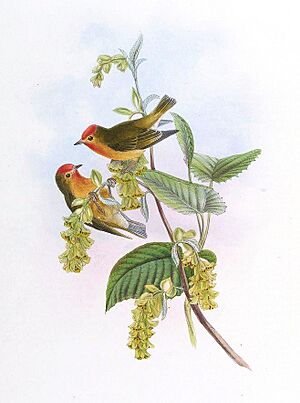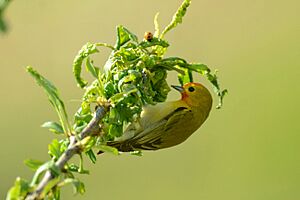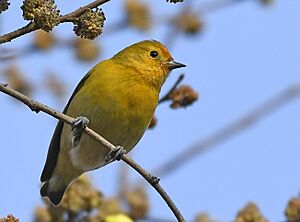Fire-capped tit facts for kids
Quick facts for kids Fire-capped tit |
|
|---|---|
 |
|
| An illustration of the fire-capped tit by John Gould | |
| Conservation status | |
| Scientific classification | |
| Genus: |
Cephalopyrus
|
| Species: |
flammiceps
|
The fire-capped tit (Cephalopyrus flammiceps) is a tiny bird. It is only about 10 centimeters (4 inches) long. It weighs around 7 grams (0.25 ounces), which is super light! This bird belongs to the Paridae family, which includes other tits and chickadees. It lives and raises its young in the cool forests near the Himalayas. You can find it in places like Myanmar and China. When winter comes, these birds fly to warmer, lower areas further south. Birds living in the eastern parts of its range are often a bit smaller and have darker feathers.
Contents
What Kind of Bird Is It?
This bird was once thought to be a kinglet. But today, scientists agree it is a type of tit. It is the only species in its own special group, called a monotypic genus, named Cephalopyrus.
It used to be placed in a different bird family, the Remizidae. However, the fire-capped tit builds its nest inside holes in trees. This is just like how "true" tits and chickadees (from the Paridae family) build their nests. Also, its eggs are blue, not white. Because of these reasons, it was moved to the Paridae family. Its small, cone-shaped bill and its song are similar to other penduline tits.
What Does It Look Like?
Male Birds
When it's not breeding season (from September to January), the male bird's head is dark olive-brown. It has a yellowish-green edge. Its upper body is yellowish to olive-green. The lower back (rump) is yellowish to olive-golden yellow. The longest tail feathers are dark gray. The tail is dark olive-brown with white tips on all feathers. The wings are the same color as the tail. They have olive-yellow edges on many feathers.
The male's throat is white. Its chest, belly, and sides are bright lemon yellow. This color stands out against the gray of its thighs and under-tail area.
During breeding season (from February to July), the male looks even more colorful. It grows a small orange-red crest on its head. The area around its eyes and eyebrows turns golden yellow with a hint of red. Its cheeks and neck sides are olive-yellow. The chin and upper throat are bright orange, blending into a golden yellow chest. The sides of its chest and upper body are yellow-olive. The lower belly is pale yellow. The white tips on its tail and wing feathers might look worn out.
All year round, the male's eyes are brown or dark brown. Its bill is dark blue-gray with a darker tip. Its legs and feet are dark blue-gray. The feathers under its wings are white with a yellow edge.
Female Birds
Outside the breeding season, the female looks similar to the male. However, her upper body, including her cheeks and neck, is more olive-green gray. Her chin and throat are whitish-gray. This blends into the dull gray of the rest of her underside. Her chest has a yellow-olive tint. Her upper sides and belly are pale yellow. The feathers under her wings are gray.
During breeding plumage, the female's forehead is yellow-olive drab. Her chin, throat, and chest are olive-yellow. This color contrasts sharply with her whitish-yellow belly.
Eggs
The eggs of the fire-capped tit are a dull blue-green color.
Sounds and Songs
The fire-capped tit makes high-pitched, quick calls. It sounds like "tsit-tsit-tsit-tsit" repeated often. Its contact call, used to talk to other birds, is a soft, low "whitoo-whitoo".
When the male sings, he often flies or sits on a high spot, like the top of a tree. His song can last for several minutes. It is a series of fast, high notes that form clear phrases. It sounds like "pit'su-pit'su-pit'su-pit'su".
How It Behaves
The fire-capped tit is not a shy bird. It is always active, moving its wings a little like a warbler. It reminds people of another small tit, Sylviparus modestus. During migration and in winter, these birds usually fly in small groups. Sometimes, you might even see groups of up to 100 birds! Most of the time, these groups are only fire-capped tits. But sometimes, they join other bird species when looking for food.
Their flight is strong, like that of finches. They look for food high up in large trees. But they also search in bushes close to the ground. These birds are very agile. They can get into acrobatic positions, like hanging upside down. They can also slide along vertical branches, just like parrots! This tit can even open rolled-up leaves with its beak and hold them with its foot.
What It Eats
The fire-capped tit mostly eats insects. But it also eats leaves, flowers, buds, and probably pollen and tree sap. When it catches a large insect, it holds it with its feet. Then, it uses its bill to open the insect and eat the inside. It throws away the empty shell. This is similar to what other tits do. But unlike them, the fire-capped tit does not cut its food into tiny pieces.
Nesting and Reproduction
The nesting season for the fire-capped tit is from early April to mid-June. The birds build their nest inside a hollow in a tree trunk or a large branch. They prefer holes where the entrance is protected by a branch or a scar on the tree. They usually use natural holes. But they often take over an old nest made by a woodpecker. Sometimes, they might even dig a hollow where a rotting branch has fallen off.
The nest is usually 6 to 12 meters (about 20 to 40 feet) above the ground. It is often very hard to find. The nest itself is shaped like a bowl. It is built from dry grass and small roots. Sometimes, it has a few feathers. The inside is lined with finer grasses and more feathers. The female bird builds the nest. The male bird protects their territory.
There are usually four dull blue-green eggs. We don't know how long the eggs take to hatch. If the female is disturbed, she tries to scare away intruders. She puffs up her feathers and makes hissing sounds. We don't know if the male helps with incubating the eggs. Both parents feed the young birds. The female takes care of keeping the nest clean by herself.
Where It Lives
The fire-capped tit lives in forests, woodlands, and areas with scattered trees. It prefers temperate rainforests and mixed deciduous forests. These forests often have oak, hazel, elm, and walnut trees. It likes to live just below the areas where conifer trees grow. At higher altitudes, it can be found among cherry trees and scattered willows. In Kashmir and Ladakh, it nests in shrubs high up in the mountains. In China, it has been seen in spruce, fir, and rhododendron forests. In Thailand, it stays in deciduous hillside forests.
The altitude where it nests changes depending on the region. In Pakistan, the fire-capped tit nests between 1,800 meters (5,900 feet) and 2,600 meters (8,500 feet). In northwest India, it nests from 1,800 meters (5,900 feet) to 3,500 meters (11,500 feet). In Nepal, it nests from 2,135 meters (7,000 feet) to 3,000 meters (9,800 feet).
Birds from the western areas spend the winter in the plains of North-Central India. Birds from the eastern Himalayas spend November to May in southern Sikkim. There, they live between 300 meters (980 feet) and 1,400 meters (4,600 feet). In the far east of its breeding range, the birds don't move as much for winter. In Sichuan and Burma, they stay at higher altitudes, around 1,800 meters (5,900 feet), even in winter. During winter, it can also be found in evergreen broad-leaved forests in Thailand.
Types and Where They Are Found
There are two main types, or subspecies, of the fire-capped tit:
- C. f. flammiceps (E. Burton, 1836) - This type breeds from Northern Pakistan (Gilgit) and Kashmir in the west. Its range goes all the way to Western Nepal in the east. It is also found in North-Central India, but it does not breed there.
- C. f. olivaceus Rothschild, 1923 - This type breeds from Eastern Nepal in the west. Its range extends to Bhutan, North-Eastern India (Assam, Arunachal Pradesh, Sikkim), and southern China. This includes South Ningxia, South-East Gansu, South Shaanxi, South and Central Sichuan, South-East Xizang, Yunnan, and West Guizhou. It is found in foothills. Rarely, it is also seen in East Myanmar, North-West Thailand, and North-West Laos, but it does not breed in these places.




